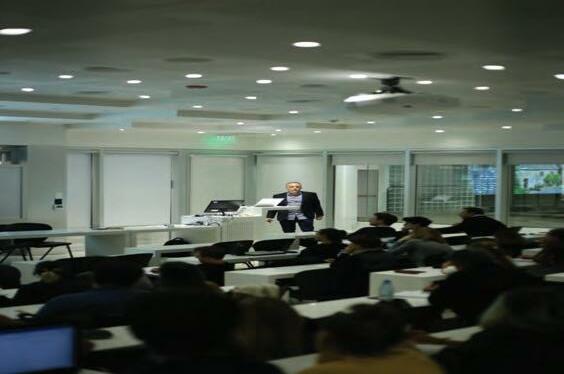
8 minute read
Michael Hensel
Michael Hensel, Embedded Architecture, 8 de agosto de 2019. Fotografía: Juan Ignacio Palma. Archivo EAEU.
Embedded Architecture Michael Hensel
Advertisement
Embedded Architecture vincula arquitectura, arquitectura del paisaje, diseño urbano, micro-climatología y ecología a través de un enfoque multiescalar y multidominio. Mientras la arquitectura orientada a la performance aborda las interacciones entre arquitectura y ambiente, la arquitectura embebida empuja este enfoque hacia su integración. Esta integración expande la pregunta acerca de la arquitectura al servicio del entorno biofísico hacia una arquitectura entendida como parte integral de este. La atención se centra en el entorno, afiliando prácticas culturales dirigidas al uso, la modificación, y el mantenimiento de los paisajes naturales y productivos gestionados por los humanos, expandiendo la idea de arquitectura a las construcciones en sentido amplio. La conferencia elabora este enfoque, propone sus principios, y presenta trabajos realizados por OCEAN Architecture | Environment y el Departamento de Arquitectura y Planificación Digital de la Vienna University of Technology.
Environment
Leslie Martin said in 1967 that the ultimate problem for the profession, meaning architecture, is that of setting out the possibilities of choices in building an environment. Not in doing a building in an environment, but in building an environment. He does not mean building the built environment, he is using it in a much broader fashion. Research centres, at that time, were not a frequent occurrence. They began to be clusters with slightly different approaches where methods were developed and the interaction between architecture and the environment was initiated.
Language
Can architecture be in the service of the biophysical environment? By bio-physical, I mean a combination between the biological environment, all the species that are around, and the physical, the geographical and geological aspects, as well as climate. Can architecture not be adverse, not be an obstacle? Can it be in service? I find myself very often in a strange situation, on some field measuring things. It is initially awkward and my colleagues from the architectural side find it intensely uncomfortable, because we have to talk to people whose language we do not understand.
House or Garden
The preliminary conclusion is that as we start modifying the environment, transforming it through new solutions, and that these new solutions need to be anchored somehow in culture, or landscape, or related practices that make these spaces recognizable and inhabitable to people. The dichotomy between the object and the ground meets two conditions that we know well. Where you have your house, you do not have your garden. Where you have your street, you do not have your garden. The constructions that separate the environment into parts bring with them the leftover areas, which are then thought as a garden or a park.
Non-human
When we talk about users, design it does not cut it, because it boils down to people that have only a functional relation to the things around. Human-centred does not cut it either, because if leaves all the other participants out. I am a fervent supporter of the nonhuman term, an inclusive approach where the centre is shared with others. The first question is: when we build into a settlement
form, do we generate any outcome for a new shared ground?
Everyman’s Right
Some of the most explicit practices that have to do with individually and collectively inhabitation of the landscape are the Scandinavian versions of the right to roam, which gives the rules by which you can walk into forest areas that are not publicly owned. In Scandinavia, this comes from early medieval times. When I arrived in Oslo, I got curious about this everyman’s right and the way it was still enacted in the landscape. I was intrigued that these kinds of rules were accepted and enjoyed as a norm, but the urban environment was developing in the exact opposite direction, into the exclusion of undesired people from certain parts of the city. How do I behave in totally opposite directions depending if I am in the city or in the landscape? I began to ask myself what could be the urbanism, or the architecture, of the everyman’s right.
Research and Business
Over the last 10 years I have taken an interest in how offices are beginning to embrace research as part of their practice model. We have mapped 40 to 50 practices across the world and how they organize themselves around research, how they build it into their business model, and what kind of questions they are asking. One of the big questions coming up more often does not have to do with the green roof, but on how to record and register over time what is growing in that roof, how much of it is changing, what the changes indicate, and what kind of dynamics are at stake.
Building Physics
Initially, students are overwhelmed with the relation between the different factors that influence one another. They quickly look for a way of mapping using open-source techniques to make the data operational. They then come up with strategies. Strategy number one was to put the main rooms underground, gaining thermal mass per area. The other strategy consists in atomizing the research centre into a series of individual interventions spread along the water supply, small constructions. This started my interest in people working with building physics for exterior conditions. We are starting research on how a building can be an extension of an ecosystem, which implies that you control the space right on the surface, and adjacent to it.
Data and Information
We have a potential excess of information and data creation. But what is the difference between data and information? Data is something you may collect on a site, something you acquire, from the Internet or other sources. But it is unstructured. It does not tell you anything unless you come to it with a question. When you have a question you begin to structure the data, then you might have something closer to an action over what is called information.
From Information to Knowledge
How do you come from information to knowledge? This requires an element of abstraction and generalization. This is where Thomson Reuters perceives the growing gap between the pack of information and the step towards knowledge, which requires methods. Interestingly, architects have a great domain of research activity and a lot of history of design activity that already takes into consideration methods related to the generation of knowledge.
Activating Data
There are different ways of obtaining data. When you do not have access to existing databases, then you have to ask yourself how to acquire data. There is also not a guarantee that the data that has been collected for a particular purpose is suitable, even if it is within the domain or the scale range that you are looking for. We have to build this diagram in our minds. There is not a deeper wisdom I can impart on that, but there is some thinking
that gets triggered by that. The nature of data, its accessibility, and what you need to do in order to make it operational, means checking the balance between the data acquired and the data turned into knowledge.
Fire
This is called the grass tree. These plants have highly combustible components that burn immediately when there is a fire. They encode the outside. But, before the rest of the material can start to burn, there is a big time-gap. The tree would have to burn for at least half an hour before the other material starts to burn. The combustible material burns, but there is nothing else to burn, so the fire moves on. We need to take these kinds of considerations into design. This is truly parametric design: you must understand the central parameters, which are unavoidable, without destroying the environment, and organize them in a manner by which you can make meaningful design dimensions.
Robot Hedging
We are looking into hedging. It is an old technique of making fences. You have trees cut sideways at 80 percent. They stay connected, so they stay alive. And then you grow hedges. It is a heavily intensive work, because it has to be done by hand. But what is the purpose of these hedges? On the one hand, they are fences, enclosures of subdivision of the property of the land. The second purpose is that these are windbreakers, and produce a particular microclimate in the area. And third, they are ecological corridors where some species live. These hedges are part of the economy of the region, where you harvest material for building that needs to be cut out on an annual basis. The problem is that they are labour intensive and costly. But we live in a time of robots, and I wonder whether we can be employed in these kinds of processes, to bring the regenerative logic back into our economy to helps us deal with the excessive labour costs while obtaining materials locally. Process of Integration
We need solutions within the foreseeable future. This involves the relation between technology, labour, ecology, the environment, and weather or culture. Landscape practices allow us to recognize and engage with these sciences. It is a humongous job but, as you know, every time you do something for the first time, it is incredibly difficult. The next time it is a little bit easier. You can integrate something else, and you can work your way forward.
Extractos de la conferencia de Michael Hensel, con introducción de Ciro Najle, organizada por el Centro de Estudios de Arquitectura Contemporánea, el 8 de agosto de 2019.











